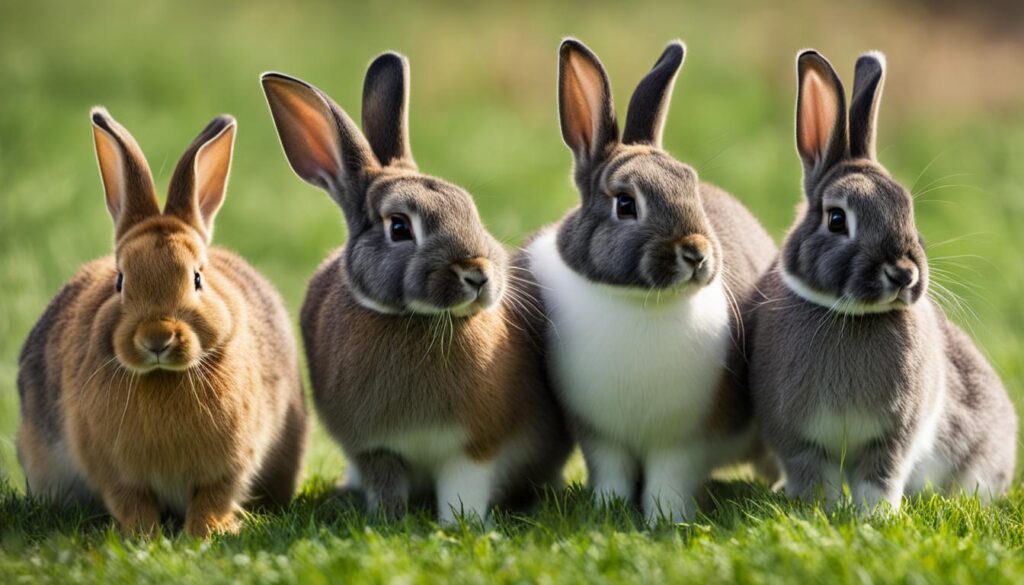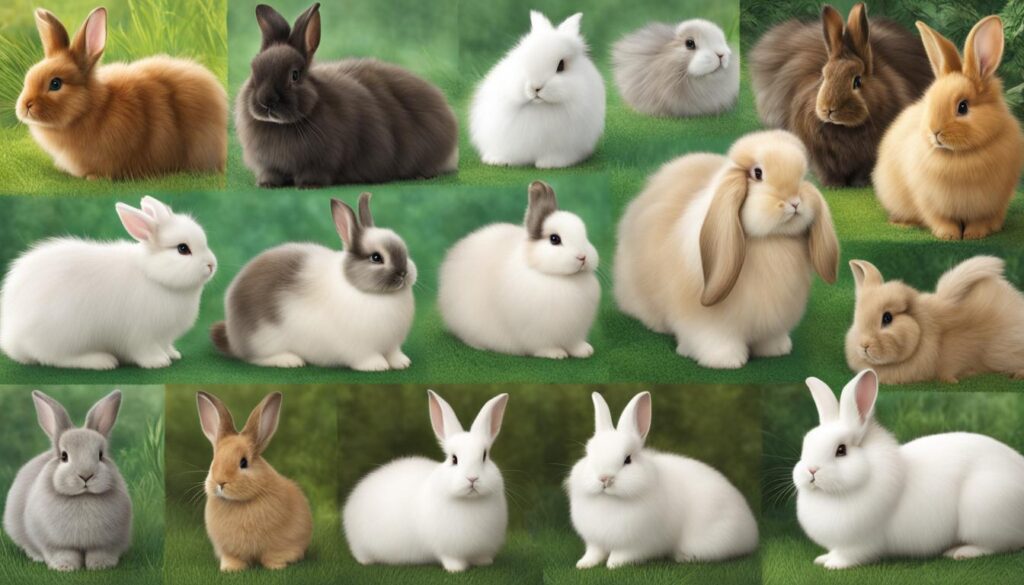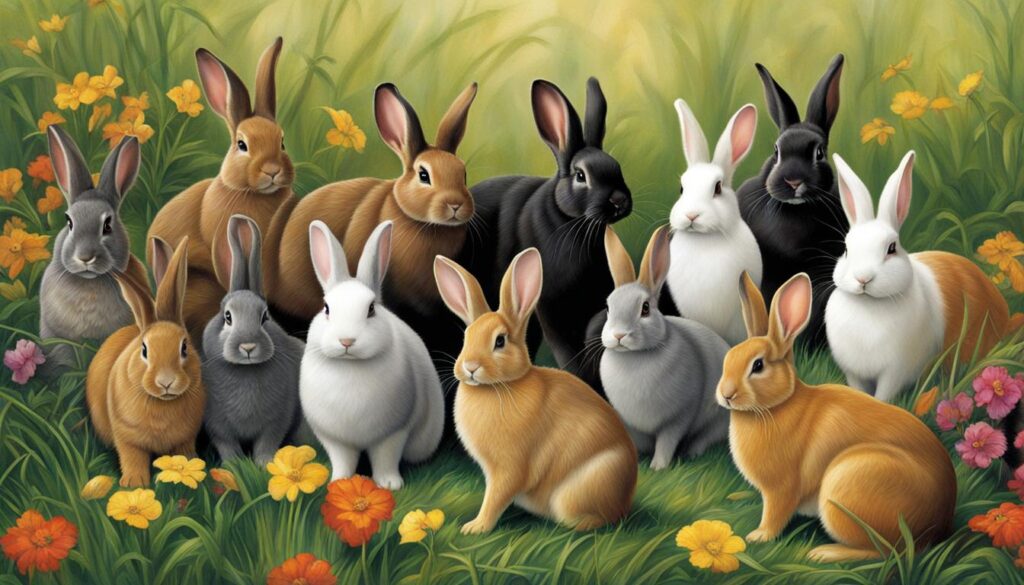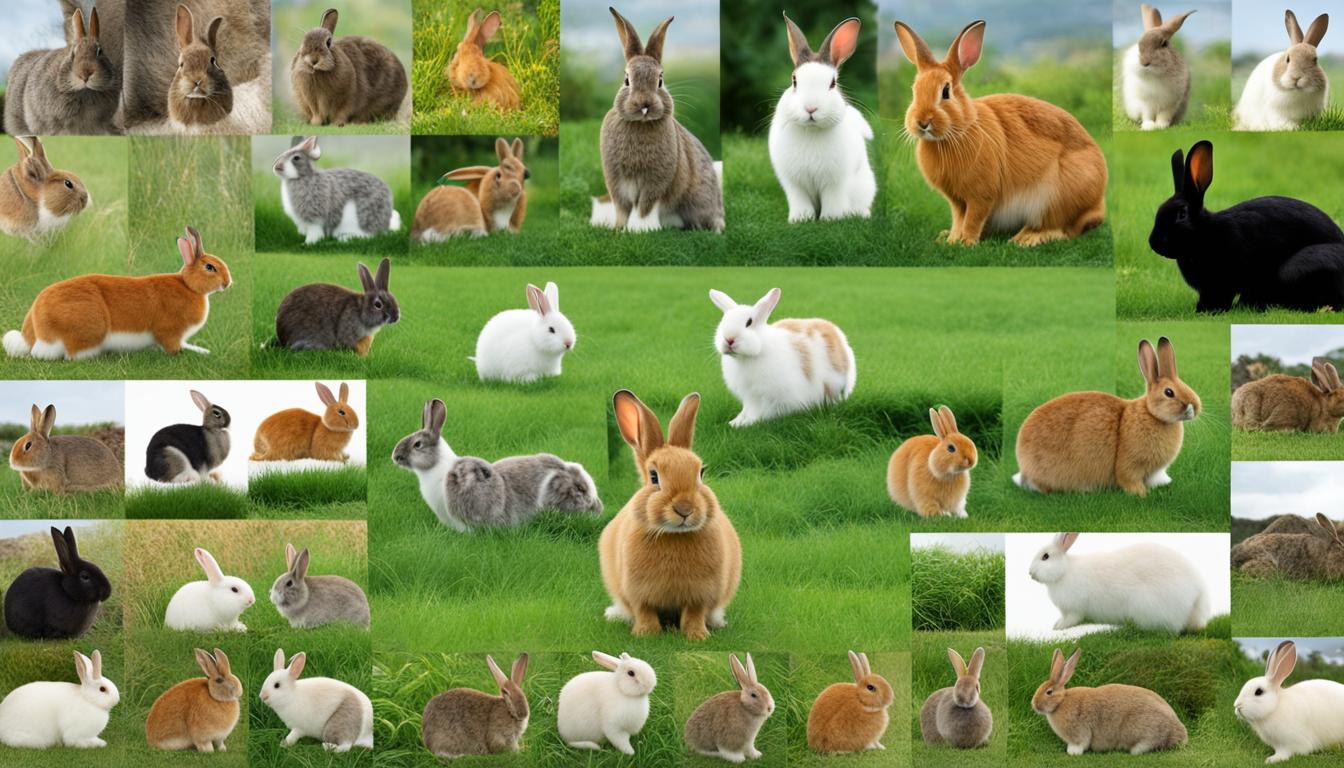A World of Variety: Exploring Different Rabbit Breeds and Their Characteristics
Welcome to the fascinating world of rabbit breeds! If you’re considering a pet rabbit, you’ll be delighted to discover the wide variety of breeds available. With over 180 different rabbit breeds, each one offering its own unique characteristics, there’s undoubtedly a perfect furry friend out there for you.
Understanding the traits and characteristics of different rabbit breeds is essential in choosing the right one for you and providing the best care. From size and fur type to temperament and care requirements, each breed has its own distinct qualities.
Key Takeaways:
- Rabbit breeds offer a wide range of options for potential pet owners, with over 180 recognized breeds.
- Each rabbit breed has its own unique characteristics, including size, fur type, and temperament.
- Choosing the right breed is crucial in providing proper care and ensuring compatibility with your lifestyle.
- Proper care for pet rabbits includes a balanced diet, regular grooming, and suitable living conditions.
- Embarking on the journey of rabbit ownership can bring joy and love into your home.
The History and Classification of Rabbit Breeds
The world of rabbit breeds is not merely a product of chance, but rather a result of centuries of evolution and intentional breeding. Understanding the history and classification of rabbit breeds provides valuable insight into the diverse range of species we have today.
Domestication of Rabbits
The process of domestication of rabbits can be traced back approximately 1,400 years ago, with the species Oryctolagus cuniculus, commonly known as the European rabbit, serving as the foundation for the numerous breeds we recognize today. The European rabbit originated in Southern France and the Iberian Peninsula, gradually spreading to various regions across the globe.

Classification of Rabbit Breeds
Rabbits do not fall under the category of rodents; instead, they belong to their own order called Lagomorpha. While they were initially classified in the Order Rodentia, differences in their diet and anatomy led to the creation of a separate order.
Within the world of rabbits, breeds are classified through selective breeding, a process that involves emphasizing specific traits and characteristics. This intentional breeding aims to achieve consistency in terms of both physical appearances and behavioral traits. The American Rabbit Breeders Association (ARBA), which serves as a recognized authority, currently acknowledges 49 distinct rabbit breeds, each with its own set of unique features.
Rabbit breeds have different sizes, fur types, and temperaments, making them suitable for various purposes and preferences. This classification allows potential rabbit owners to select a breed that aligns with their specific needs and preferences, ensuring a harmonious relationship between rabbit and caretaker.
Popular Rabbit Breeds and Their Traits
Among the recognized rabbit breeds, some have gained popularity for their unique traits. Whether you prefer small, large, or fluffy rabbits, there is a breed out there that will capture your heart.
Small Rabbit Breeds
If you’re looking for a compact and adorable pet, consider small rabbit breeds. Popular choices include:
- Holland Lop
- Netherland Dwarf
- Mini Rex
These breeds have captivated pet owners with their pint-sized cuteness and playful personalities. Their small size also makes them well-suited for apartments or homes with limited space.
Large Rabbit Breeds
If you desire a rabbit with an impressive presence, large breeds are the way to go. Some sought-after large rabbit breeds include:
- Flemish Giant
- Californian rabbit
These rabbits are known for their majestic size and gentle nature. Their commanding appearance will surely be a conversation starter, and they make great companions for families with ample space to accommodate their needs.
Fluffy Rabbit Breeds
If you adore soft and fluffy fur, consider getting a rabbit from one of these breeds:
- Lionhead
- Angoras
The Lionhead breed boasts a distinctive mane-like fur growth around their head, hence their name. Meanwhile, Angora rabbits have long, silky fur all over their bodies. These fluffy breeds require regular grooming to keep their fur healthy and tangle-free.
Each breed has its own distinct personality traits and care requirements. Whether you’re seeking a small, large, or fluffy rabbit, take the time to research and understand the unique needs of your chosen breed. Finding a breed that aligns with your lifestyle will ensure a fulfilling and harmonious companionship.

| Breed | Traits |
|---|---|
| Holland Lop | Compact size, floppy ears, sweet temperament |
| Netherland Dwarf | Small size, round faces, energetic |
| Mini Rex | Plush fur, playful, curious |
| Flemish Giant | Impressive size, gentle, friendly |
| Californian rabbit | Large size, striking coloration, docile |
| Lionhead | Mane-like fur, friendly, inquisitive |
| Angoras | Long, silky fur, gentle, requires regular grooming |
The Process of Breed Recognition
Gaining breed recognition by the ARBA is a rigorous process. Rabbit breeders must follow specific criteria and guidelines set by the association. To be considered for recognition, a breed must be new and demonstrate unique characteristics that differentiate it from existing breeds. The breeder must obtain a Certificate of Development from the ARBA and go through a series of showings at ARBA conventions over several years. The breed must consistently meet the standard of perfection set by the ARBA to be officially recognized.
“Gaining breed recognition by the ARBA is a testament to the hard work and dedication of rabbit breeders. It is a mark of excellence and a reflection of the breed’s adherence to the highest standards of quality and uniqueness.” – Jane Smith, Rabbit Breeder
The recognition process begins with a breeder identifying a new breed with distinct traits and characteristics. Once identified, the breeder must apply for a Certificate of Development from the ARBA. This certificate acknowledges the breeder’s intent to develop a new breed and provides guidance on the breeding and selection process.
After obtaining the Certificate of Development, the breeder must go through a series of showings at ARBA conventions. These showings allow the breed to be evaluated by judges and fellow breeders. The breed must consistently demonstrate the unique characteristics outlined in the breed standard and show improvement over time to progress towards official recognition.
The breed standard serves as a guideline for breeders and judges, defining the ideal characteristics and appearance of the breed. It includes details such as size, body shape, fur type, color, and temperament. Meeting the breed standard is crucial for breed recognition, as it ensures the breed’s uniformity and distinguishes it from other breeds.
During the conventions, breeders have the opportunity to showcase their breed, discuss breeding practices and share knowledge with other rabbit enthusiasts. These events foster a sense of community and provide valuable feedback for breeders to continue refining their breeds.
Once a breed consistently meets the standard of perfection set by the ARBA and demonstrates stability in its characteristics, it can be officially recognized by the association. The ARBA recognition provides breeders with credibility and opens up opportunities for breed promotion and competition.

Conclusion
Choosing the right rabbit breed for your family requires careful consideration of their characteristics and your lifestyle. Each breed has its own size, fur type, and temperament, so it’s important to research and understand the specific needs of your chosen breed.
Providing proper care, including a balanced diet, regular grooming, and appropriate living conditions, is essential for keeping your furry friend happy and healthy. Rabbits thrive in a clean, spacious environment with plenty of exercise and social interaction. By providing a nurturing and stimulating environment, you can ensure the well-being of your pet.
With so many rabbit breeds to choose from, ranging from small and fluffy to large and majestic, you’re sure to find the perfect companion for your home. Whether you prefer a compact Holland Lop or a regal Flemish Giant, owning a pet rabbit can bring joy, love, and endless entertainment to your household. So, embark on the journey of rabbit ownership and discover the unique pleasures that these adorable creatures can bring to your life.
FAQ
How many rabbit breeds are there?
There are over 180 breeds of rabbits, with 49 recognized by the American Rabbit Breeders Association (ARBA).
What is the basis for domesticated rabbit breeds?
Domesticated rabbit breeds are derived from the species Oryctolagus cuniculus, also known as the European rabbit.
What are some popular small rabbit breeds?
Some popular small rabbit breeds include the Holland Lop, Netherland Dwarf, and Mini Rex.
Which rabbit breeds are known for their large size?
The Flemish Giant and Californian rabbit are popular choices among those looking for large rabbit breeds.
Are there any fluffy rabbit breeds?
Yes, there are fluffy rabbit breeds such as the Lionhead and Angoras, known for their long, silky fur.
How does a breed become recognized by the ARBA?
Breeders must follow specific criteria and guidelines set by the ARBA, including obtaining a Certificate of Development and demonstrating unique characteristics.
What should I consider when choosing a rabbit breed?
Consider the breed’s size, fur type, and temperament, as well as your own lifestyle and preferences.
What is the key to providing proper care for pet rabbits?
Proper care for pet rabbits includes a balanced diet, regular grooming, and appropriate living conditions.

